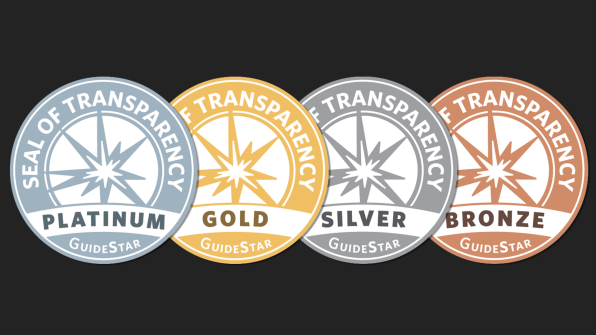More transparency means nonprofits get more donations
Nonprofits face some serious trust issues: About a third of Americans don’t trust charitable groups to spend their funds well, and more than 60% of people globally don’t have faith that groups can accomplish their missions. But groups that perform well may be able to raise more money simply by becoming more transparent: People like having the opportunity to vet places themselves before making a contribution.
That’s the key takeaway from a recent study published in Journal of Accounting, Auditing & Finance. Researchers from Villanova University and University of Wisconsin found that charities earning a seal of transparency from the nonprofit GuideStar gained an average of 53% more contributions one year later. Those ratings currently cover four levels, each with differing degrees of public disclosure (bronze, silver, gold, and platinum). And the more transparent a group gets, the potentially bigger the bounce. For instance, silver-level awardees earned roughly 26% more contributions than those with bronze.
“The aim of the program is really to recognize organizations for being transparent, for sharing information in a structured and comparable format on GuideStar,” says Eva Nico, GuideStar’s senior director of Nonprofit Programs. “We believe that actually allows donors to support more effective nonprofits because they can find out how a nonprofit works and operates.” For nonprofits, there are other benefits, including being able to more clearly understand how others in their sector operate and to what effect. That might entice groups with similar missions to refine their efforts or even join forces.

For the study, researchers analyzed data from 2013 and 2014, the first year GuideStar began offering their certification process, which is free. The seals, of course, all have different standards, ranging from basic program information (bronze), to deeper financials (silver), to more about goals and strategies (gold). In 2016, GuideStar added the platinum seal, which involves quantifying progress and results.
Once a group earns a seal, it is affixed to their profile on the service. Nonprofits can also advertise that achievement on their own materials free of charge. For potential donors, GuideStar also has a search function that allows people to look for groups by what seal they earned. In general, GuideStar reports that that profiles with gold or platinum seals now receive twice the views of other profiles. In 2017, 78% of the nonprofits that earned contributions directly through the organization’s donation portal had some sort of seal.
Since the inception of the seals, a lot more nonprofits are seeking that boost. While the initial study looked at more than 6,000 groups, the service now has more than 66,000 that received some sort of seal, something GuideStar hopes to learn about in future studies. “In some cases we have heard of funders who explicitly asked organizations to earn a particular seal,” Nico adds. “It makes it easier for them to get comparable information about organizations, and then they believe that it also helps that organization reach a broader audience.” It also gives GuideStar a lot of power in deciding which organizations get funding.
(21)



